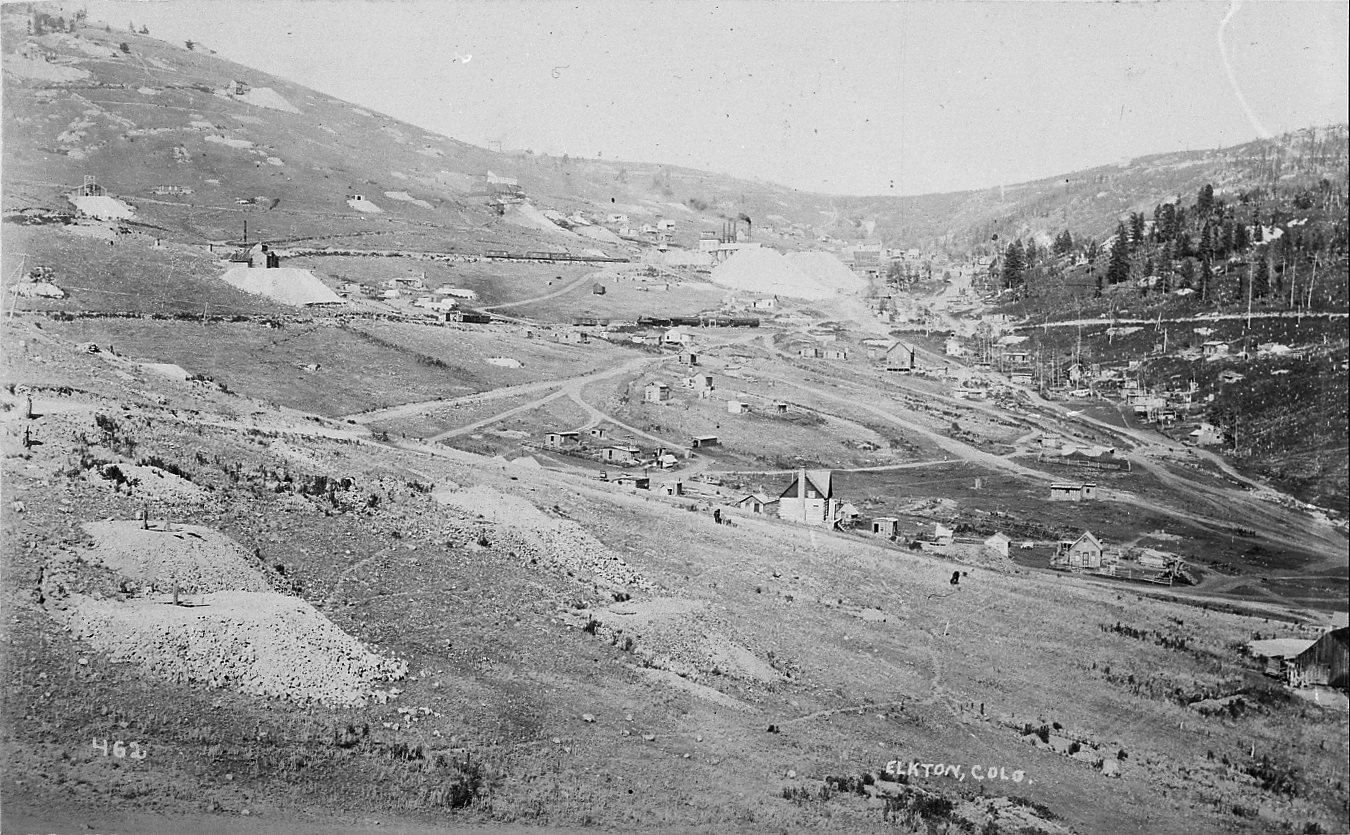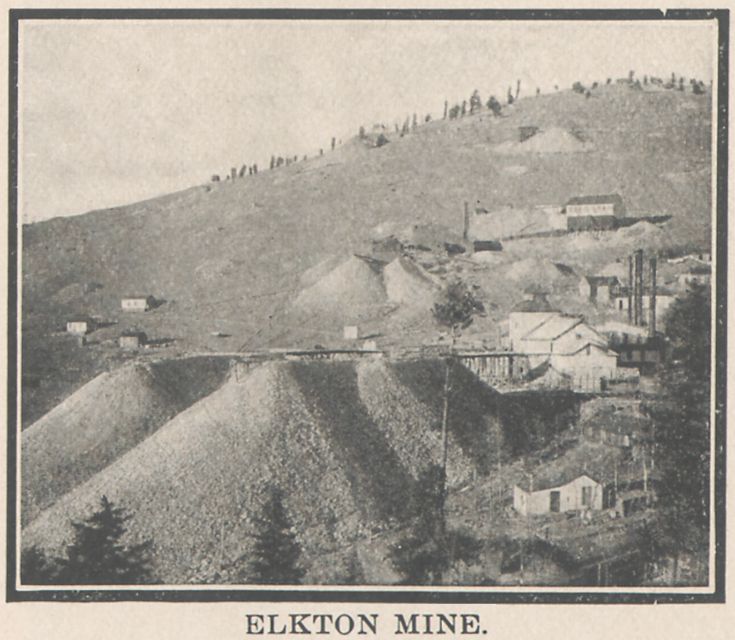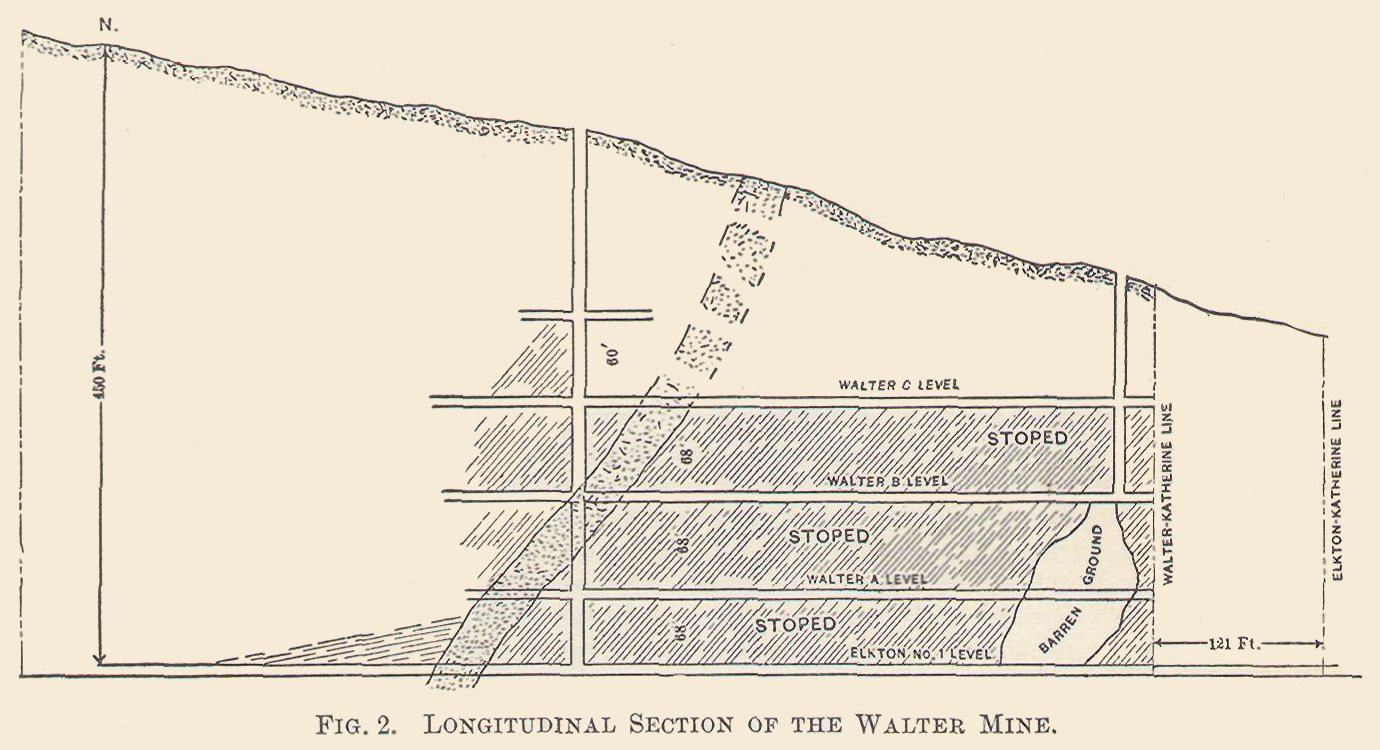-> My Collection; No source to show as I've not shared the Mining Journal as an album.
But, here is a link to first page on Hathi Trust Digital Library website.
November, 1899 (page 154->155)
Source had no images, only 1 sketch/drawing of the Elkton vein, so I used a some images from my collection.
One of the most interesting of the group of hills that form the Cripple Creek mining district, proper, is Raven hill. Here are located some of the largest and richest mines of the district. It adjoins its distinguished neighbors, Bull hill and Battle mountain, on which are the Portland, Anna Lee, Independence, and other noted mines. Both hills are close to the junction of the volcanic breccia and granite, and from the Elkton mine one can look across the intervening gulch and see a well-defined line of demarcation between these two formations, the granite of Squaw mountain being indicated by the growth of fir trees, and the breccia by their absence. This line of different material descends Battle mountain and crosses the intervening gulch to one side of Raven hill, where the outcrop of the granite is shown in a fir-crowned hill at the Thompson mine, adjacent to the Elkton property.
There is much reason to believe that these hills are very near to, or within the area of, the Cripple Creek volcanic crater. The granite adjoining the volcanic breccia is much fractured; in some places, even, it is itself broken up into a breccia, while in other places it is much decomposed and traversed by dikes and fissure veins along the zone of contact. In other places the necks of fumaroles are a conspicuous feature, a phenomena such as would be likely to occur very near to, or at a central focus of, an eruption.
"The ore deposits in this area," says Professor Penrose, "are intimately connected with the eruption of the dikes. Ore may occur in fissures formed after the dike intrusions, or in fissures formed previously. Veins occupying these fissures may follow these dikes or be deflected along them. Most of the important mines are in fissures following dikes, or dike courses. Ore deposition depended on the heated rocks for its effects. The shrinkage cracks, formed in the dikes at their contacts with country rock, offered places for ore deposit.
"These effects produced a connection between dikes and veins, the dikes often directing the course of the later fissures in which many of the veins were deposited. The dikes are lines of weakness, both from occurring in older fissures and because of the shrinkage cracks formed along their sides in cooling. Contact of two different rocks is a common line of weakness, hence the dike's course was the line of easiest fissuring, and later fissures often followed this line, finally leaving it to follow its normal course.
''Fissures following dikes often adhere to one side of them, as shrinkage cracks make these positions lines of easy fracture. They may cross and recross the dikes at short intervals. Sometimes the veins follow, or cross the dip, or are deflected along the dikes for a distance. Ore is as apt to occur with one kind of dike as another. Parallel cracks or 'sheeted zones' occur in dikes at their contact with country rock, due to shrinkage of the dike along the contact during cooling."
The Raven, Moose, and other mines on this hill, illustrate these phenomena, which are common also to the Elkton, Katherine, and Walter claims we are about to describe under the title of the Elkton mine. These lie on the south slope of Raven hill, below the Raven mine. Here the ore occurs associated with two dikes enclosed in breccia. The younger of these has supplied most of the Elkton ore; the older, that of the Katherine. The Elkton strikes north and south, dipping steeply; the Katherine strikes west of north and is vertical. The dikes meet and cross between the Katherine and old Elkton shafts, the Elkton dike intersecting the Katherine. Ore in both dikes is in veins following the course of the dikes and is composed of rock replaced by iron pyrite, iron oxide, quartz, and fluorite with free gold and telluride.
The Katherine dike is 2 to 4 feet wide, and the ore body is a few inches to a foot or more wide; southward the dike widens to 10 feet. The ore often adheres to the contact of the dike, and forks, and continues along the abandoned side of the dike for a few feet, finally thinning out and disappearing. The dike is broken by cross joints intersecting it, and these are, at times, lined with a film of iron pyrite and telluride, converting the dike into almost a mass of ore.
This preliminary explanation is necessary to the understanding of phenomena that would otherwise be a more difficult puzzle to one examining the underground workings of the Elkton mine.
Elkton Mine.—We approach the great dump and plant of the Elkton mine by a switch of the Midland Terminal Railway, lately run up in front of the ore bins, so that the ore is loaded directly into the cars, a great advantage over former times and modes.
Inside the spacious building over the mine, blacksmiths are busy sharpening and tempering big bundles of air drills, like sheaves of spears for a battle; close to them on the same floor men are ascending and descending, and ore is coming up from the shaft, which is 500 feet deep. On the same floor, too, are the powerful engines with three big boilers, one 66 inches by 16 feet, another 72 inches by 16 feet; and a third, 60 inches by 16 feet; in all 550 horsepower. The engines need to be powerful, for not only is there an output of 2,000 tons of sulphide ore monthly, beside the waste rock, but there are 600 gallons of water per minute to be contended with in this great mine.
We descend first to the fifth, or lowest level. Running along, and forming the roof of this level, is the nepheline basalt dike that so largely carries, as well as influences, the ore deposit. It is a dark, almost black, fine-grained rock, speckled with little white, oval spots, which are amygdaloidal cavities, caused by escape of steam filled later with white crystalline matter carrying a good deal of lime.
This dike is divided lengthwise by numerous parallel shrinkage cracks, and crosswise, at intervals, by others. On the edges near the contact with the breccia, the dike becomes less amygdaloidal, harder, and more slaty, and of a lighter color. This change indicates the ore presence or impregnation for a width, it may be, of a few inches to a foot on one side, or both, of the dike. This zone shows fine veinlets of purple fluorite running through it, and on splitting the rock you find both faces coated with the purple matter on which lie scattered the bright silver-like flakes of telluride. Following the dike on its course in places we find all the shrinkage lines occupied by ore, and nearly the whole dike a mass of valuable metal. Again the dike may leave the line of what is called the Walter fissure, and strike off to the west quite abruptly into the wall rock. This sudden movement may, at times, be accompanied by faulting, at others the finding of dike matter back from, and parallel with, the main dike may possibly be accounted for by the molten matter having come up, not through one fissure, but through a much fissured zone of many short parallel fissures comparatively close together. Again we saw places where the main line of fissure was for a long distance unoccupied by the dike, the fissure line marked by an altered zone of gray quartzose breccia yielding ore in some places, and in other places barren.
At one point we saw what, for a long time, had naturally been mistaken for the true and limiting wall of the ore body, until it was broken through and good ore found beyond it.
Approaching what is called the Walter end of the property is a rather sudden and strongly marked transition from oxidized to "live," or unoxidized sulphide ore. In this direction are some exceedingly rich bodies of ore in narrow veins. At a point along this fifth level, a lighter colored dike, resembling phonolite, comes in from northwest to southeast, cutting diagonally through the basalt dike whose course is north and south, and producing a large enrichment of the ore body at the point of crossing.
From the fifth level we ascended to the fourth. The upper levels are quite dry, but the lower ones are very wet. The water comes from the fissures, or shrinkage cracks, in the basalt dike, and drips down in streams from the cracks in it, and when first tapped under pressure, goes off like a shot gun. In consequence of the water which is now becoming a common feature of many of the deeper Cripple Creek mines, which, in early days, were so remarkably dry, large pumps are a necessity in the lower levels. There is a large pump in the bottom level, and a whole room full of pumps in the station of the fourth level. Four pumps are running all the time; one is of the Snow pattern, another Cameron, and two others Knowles. The station Knowles pumps are triple-expansion. The pumps are about 100 horsepower, handling unitedly about 600 gallons per minute.
Ascending to the upper levels we found them quite dry. In early days the basalt dike in these levels was soft and slacked readily, and by reason of this and its jointed structure, large blocks were liable to drop from the roof. On our first visit, some years ago, a man had just been killed by the fall of one of these. At that time the ore was found in quartzose matter between the dike and breccia at the "contact," and with the ore was often much loose sandy matter which, on panning, showed fine colors of free gold. The dike with depth became harder, although much wetter. Generally speaking, free gold abounded near the surface, but with depth passed into telluride and iron pyrite, the former very high grade, the latter low grade. With depth there has been no diminution in the value and quantity of ore, but the contrary, the only obstacle in its development being the increase of water.
To the south the workings approach the granite rim. We endeavored to reach this point, but our candles flickering and going out, warned us of bad air. The granite appears to enter the breccia in a rounded mass partly surrounded by a zone of decomposed, altered granite. Slickensides are observed on it, and at contact with it, the Elkton vein ends.
The Thompson mine is working on what may be the "neck" of a fumarole, described to us as not unlike that found in the Anna Lee.
The illustration shows same characteristic features of the vein on Raven hill, showing the relations between the dike and vein. V is the vein; B the brecciated County rock, and D the dike. The black lines show shrinkage cracks, both vertical and transverse.


![Photo by: Andrew James Harlan | Click for larger view, more info On Line of Midland Ter. Ry., Raven Hill & Mines [Panorama no. 2; Middle]](/04library/images/mine/p-01253_elkton-mine-on-line-of-mt-ry,raven-hill-n-mines_aj-harlan-2.jpg)

